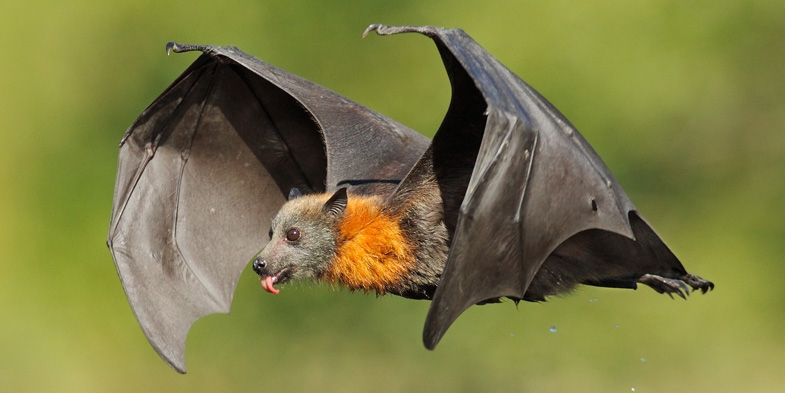Grey-headed flying-foxes are listed as a threatened species and play a crucial role in the pollination of Eucalyptus trees on the east coast. Unlike many birds that have a small range flying-foxes fly long distances and can enhance species resilience by widening the gene pool. Like the calls made by some people for sharks to be removed from our coasts, it seems that people will not accept that bats are a natural part of our environment. A little inconvenience is deemed to be unacceptable.
It’s not a good time to be a flying-fox who calls Sydney home. This year, dispersals have been carried out at the camps in Avalon and Kareela. Dispersal is threatened at Balgowlah. In addition, the Parramatta Park camp is under threat.
To make matters worse, dispersals have been approved (and carried out) at times of the year considered harmful to the animals – contravening the Office of Environment and Heritage’s (OEH) best-practice guidelines.
Cannes Reserve, Avalon
The camp at Cannes Reserve, Avalon, was dispersed at the end of July. However this coincided with the normal reduction in numbers of flying-foxes in the Sydney region – the Gordon camp was deserted soon after – so it’s debateable how much was directly due to the dispersal activities and how much to normal seasonal movement. However, in October the bats returned – as has been seen in nearly every other dispersal attempt.
Pittwater Council then carried out ‘maintenance dispersals’ – which in operation are identical to dispersals, but allowed to be conducted at times when a normal dispersal is prohibited due to the stress on the animals and threat to pregnancies. Under pressure from a handful of local residents, Pittwater Council conducted dispersals even when dependent young were present in the camp – with the full approval of OEH. And in early November, Council conducted tree trimming at night, after the bats had flown out. This resulted in the severe pruning of 12 trees used as roost trees by mothers with young, and the effective destruction of the contiguous canopy in the camp. (The vegetation type is a declared Endangered Ecological Community – Pittwater Littoral Rainforest.)
The short-term result was that the flying-foxes moved into other trees, closer to the residents who had complained. How this situation can be resolved is unclear. At present it appears that the cycle will stop only when there is nothing left of the reserve, and the bats have moved somewhere else.
The next closest camp, at Warriewood, has been abandoned for months due to adjacent construction work; the next two nearest camps are Balgowlah – itself contentious and being proposed for dispersal; and Gordon.
Kareela, Sutherland Shire
At the same time, at Kareela in Sutherland Shire, a long battle with residents resulted in Sutherland Shire Council approving for full dispersal of that camp. This camp was only established after another camp – Kurnell – was abandoned during construction of the adjacent Sydney desalination plant. The Kareela dispersal was not approved in time for action to take place under the OEH guidelines (May to July) which are supposedly in place to minimise harm to the animals, so were approved to start in August.
The animals were quickly dispersed from the camp but moved to adjacent areas of bushland; they were then in turn dispersed from these. Eventually, the animals abandoned the area; it’s not known where they have gone, but it’s thought to be Wolli Creek. They have, of course, continued to try roosting in the Kareela camp. So Council staff have been conducting pre-dawn dispersals to prevent the camp re-establishing.
Like the Sydney Royal Botanic Gardens, they accept that this will be an ongoing action – probably for some years. The approved budget for this is $800,000 to $1.2 million.
Parramatta Park
The Parramatta Park camp is an interesting case – the camp is supported by both the local council and the managing body (Western Sydney Parks Trust). However a major development is planned for the area adjacent to the camp. This has been declared a State Significant Development so is out of the hands of local bodies, and proposes multi-storey apartment blocks sited just 50 m from the camp.
Out of Sydney
Further afield, there’s talk of dispersing the camps at North Avoca, on the Central Coast; and at Rudder Park, Kempsey (a camp that formed after a previous camp was itself dispersed by construction of the Kempsey bypass). There’s also a draft plan of management for the camp in Batemans Bay (which thankfully proposes in situ management rather than dispersal).
It seems that NSW is following the direction of Queensland regarding flying-fox management: hundreds of thousands of dollars of taxpayers’ money being used on what are ultimately ineffective and pointless actions which at best only result in the problem being moved somewhere else – usually worse. Ironically, Queensland councils are now starting to realise this and are in some cases pushing back against resident complaints and trying to manage the issues rather than taking the knee-jerk action of dispersal. Sadly, many NSW councils do not seem to be getting the message.
Ultimately, however, what needs to change is community attitudes towards wildlife and nature – and the recognition that humans are part of the environment, instead of above it.

